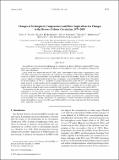Changes in Stratospheric Temperatures and Their Implications for Changes in the Brewer–Dobson Circulation, 1979–2005
Author(s)
Young, Paul J.; Rosenlof, Karen H.; Solomon, Susan; Sherwood, Steven C.; Fu, Qiang; Lamarque, Jean-François; ... Show more Show less
Download2011jcli4048.1.pdf (1.142Mb)
PUBLISHER_POLICY
Publisher Policy
Article is made available in accordance with the publisher's policy and may be subject to US copyright law. Please refer to the publisher's site for terms of use.
Terms of use
Metadata
Show full item recordAbstract
Seasonally and vertically resolved changes in the strength of the Brewer–Dobson circulation (BDC) were inferred using temperatures measured by the Microwave Sounding Unit (MSU), Stratospheric Sounding Unit (SSU), and radiosondes.
Linear trends in an empirically derived “BDC index” (extratropical minus tropical temperatures), over 1979–2005, were found to be consistent with a significant strengthening of the Northern Hemisphere (NH) branch of the BDC during December throughout the depth of the stratosphere. Trends in the same index suggest a significant strengthening of the Southern Hemisphere branch of the BDC during August through to the midstratosphere, as well as a significant weakening during March in the NH lower stratosphere. Such trends, however, are only significant if it is assumed that interannual variability due to the BDC can be removed by regression of the tropics against the extratropics and vice versa (i.e., exploiting the out-of-phase nature of tropical and extratropical temperatures as demonstrated by previous studies of temperature and the BDC).
The possibility that the apparent lower-stratosphere BDC December strengthening and March weakening could point to a change in the seasonal cycle of the circulation is also explored. The differences between a 1979–91 average and 1995–2005 average tropical temperature seasonal cycle in lower-stratospheric MSU data show an apparent shift in the minimum from February to January, consistent with a change in the timing of the maximum wave driving. Additionally, the importance of decadal variability in shaping the overall trends is highlighted, in particular for the suggested March BDC weakening, which may now be strengthening from a minimum in the 1990s.
Keywords: Atmospheric circulation; Temperature; Stratosphere; Seasonal cycle; Tropics; Extratropics
Date issued
2012-03Department
Massachusetts Institute of Technology. Department of Earth, Atmospheric, and Planetary SciencesJournal
Journal of Climate
Publisher
American Meteorological Society
Citation
Young, Paul J., et al. “Changes in Stratospheric Temperatures and Their Implications for Changes in the Brewer–Dobson Circulation, 1979–2005.” Journal of Climate, vol. 25, no. 5, Mar. 2012, pp. 1759–72.
Version: Final published version
ISSN
0894-8755
1520-0442